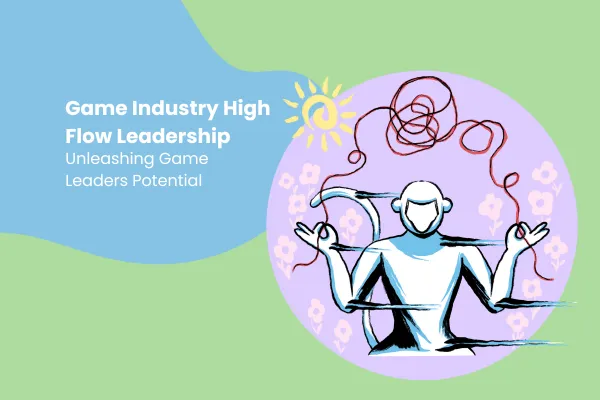Welcome to the Treasure Chest
We have hidden Golden Nuggets and secret Potions below find your relevant category and explore.


For Individuals
The section for Individual Developers and Executives or Leaders

Game Industry High Flow Leadership: Unleashing Potential
Game industry pioneer, listen up! I know you're tired of the same old leadership techniques that barely move the needle. Well, I've got a cutting-edge approach that'll blow your mind and skyrocket your team's performance. High flow leadership is the future, and it's time to embrace it.
Want to see your game development team shine? Embrace flow. When you create a workspace that encourages this optimal state of performance, you'll be amazed at the results. Creativity flourishes, engagement intensifies, and productivity accelerates. Your team will find themselves truly enjoying their work, and that enthusiasm will be evident in the exceptional games they create.
Picture a team that's firing on all cylinders, tackling challenges like a well-oiled machine. That's the power of high flow leadership. Let's break down what it is and how you can harness it to supercharge your team's performance.
Table of Contents:
What Is Flow Leadership and Why Is It Important for Game Industry Leaders?
Key Characteristics of High Flow Leaders in the Game Industry
Strategies for Cultivating Flow Leadership in Game Development Teams
Case Studies: Successful Flow Leadership in the Game Industry
Overcoming Challenges and Obstacles to Flow Leadership in Game Development
What Is Flow Leadership and Why Is It Important for Game Industry Leaders?
Flow leadership is a game-changer for the game industry. It's a concept rooted in positive psychology that's all about creating an environment where people can thrive and do their best work.
Understanding the Concept of Flow
Flow is that magical state of mind where you're completely absorbed in what you're doing. Time flies by, distractions fade away, and you're operating at your peak. As a game industry leader, your job is to help your team find that flow state as often as possible. Because when they do? That's when the magic happens.
Benefits of Flow Leadership in the Game Industry
When you embrace flow-based management, you'll see creativity and innovation skyrocket. Your team will be more motivated, engaged, and productive than ever before. Plus, by fostering a flow-friendly environment, you'll be able to attract and retain top talent in the competitive game industry. Who wouldn't want to work somewhere that prioritizes their well-being and helps them do their best work?
Developing Emotional Intelligence as a Game Industry Leader
To be a true flow leader, you need to develop your emotional intelligence. That means being attuned to your own emotions and those of your team members. It's about creating a positive, supportive environment where people feel safe to take risks and push boundaries. Luckily, emotional intelligence is a skill that can be learned and honed over time. And trust me, it's worth the investment. Your team will thank you for it.
Key Characteristics of High Flow Leaders in the Game Industry
So, what does it take to be a high flow leader in the game industry? Here are a few key characteristics to strive for:
Fostering a Culture of Creativity and Innovation
High flow leaders know that creativity and innovation are the lifeblood of the game industry. They create a culture that encourages experimentation, risk-taking, and outside-the-box thinking. They provide their teams with the resources and support they need to bring their wildest ideas to life. And they celebrate failures as learning opportunities, not setbacks.
Empowering and Motivating Game Development Teams
The best game industry leaders know how to empower and motivate their teams. They give their people autonomy and ownership over their work, trusting them to make decisions and solve problems on their own. They also know how to give feedback and recognition in a way that inspires and encourages, rather than demotivates. It's a delicate balance, but one that's crucial to master.
Balancing Technical and Soft Skills
High flow leaders in the game industry have a rare combination of technical expertise and soft skills. They have a deep understanding of game development processes and technologies, but they also excel at communication, collaboration, and leadership competencies. This unique skills profile allows them to bridge the gap between the creative and technical sides of game development, fostering a more cohesive and effective team.
Strategies for Cultivating Flow Leadership in Game Development Teams
Ready to cultivate flow leadership in your own game development team? Here are some strategies to get you started:
Setting Clear Goals and Expectations
To induce flow, you need to set clear, challenging, and achievable goals for your team. Make sure everyone knows what's expected of them and how their work fits into the bigger picture.
Providing Adequate Resources and Support
Flow leaders make sure their teams have access to the resources and support they need to do their best work. That means providing the right tools, technology, training, and guidance to help them succeed.
Encouraging Autonomy and Ownership
To foster flow, give your team members a sense of control over their work. Let them make decisions, solve problems, and take ownership of their projects. Trust them to do what's best for the game and the company.
Facilitating Collaboration and Communication
Finally, high flow leaders facilitate collaboration and communication within their teams. They create opportunities for knowledge sharing, feedback, and cross-functional teamwork. They also lead by example, modeling the kind of open, honest, and respectful communication they want to see from their team members.
Key Takeaway:
Flow leadership transforms the game industry by fostering environments where creativity and peak performance thrive. It's about setting clear goals, giving teams what they need to succeed, and valuing both emotional intelligence and technical skills. Embrace this approach to attract top talent, boost innovation, and keep your team motivated.
Case Studies: Successful Flow Leadership in the Game Industry
The game industry is no stranger to the concept of flow leadership. In fact, some of the most successful game developers and studios have embraced this approach to create innovative, engaging games that captivate players worldwide.
Examining Real-World Examples
One recent example of successful flow leadership in action is the partnership between X-Flow Games and Plummy Games. X-Flow invested $6 million in Plummy Games, a casual game developer, to support their ambition of becoming a genre leader after the successful launch of their game, Star Merge. This case study demonstrates how flow leadership can drive success in the game industry by fostering creativity, innovation, and a supportive organizational culture that empowers teams to do their best work.
Analyzing Key Factors for Success
So, what are the key factors that contribute to successful flow leadership in the game industry? Based on my experience and observations, it often comes down to a combination of elements: 1. A clear vision and direction from leadership 2. A talented, motivated team that feels ownership over their work 3. A supportive organizational culture that values creativity and risk-taking 4. Effective project management practices that balance structure with flexibility When these factors align, magic happens. Teams enter a state of flow where they're fully immersed in their work, collaborating seamlessly, and pushing boundaries to create something truly special.
Lessons Learned and Best Practices
Studying real-world examples of successful flow leadership in the game industry yields valuable lessons and best practices that aspiring leaders can apply in their own organizations: - Communicate a compelling vision that inspires and unites the team - Hire talented individuals who are passionate about their craft - Foster a culture of trust, autonomy, and psychological safety - Provide the resources and support teams need to do their best work - Encourage experimentation and learning from failure - Celebrate successes and recognize individual and team contributions By implementing these best practices, game industry leaders can cultivate a flow-friendly environment that enables teams to reach new heights of creativity, innovation, and performance.
Overcoming Challenges and Obstacles to Flow Leadership in Game Development
While the benefits of flow leadership in game development are clear, implementing this approach is not without its challenges. Game industry leaders must navigate various obstacles to successfully cultivate a flow-friendly environment.
Addressing Resistance to Change
One common challenge is resistance to change, especially in organizations with entrenched cultures or processes. Introducing flow leadership principles can be met with skepticism or pushback from team members who are comfortable with the status quo. To overcome this resistance, leaders must communicate the benefits of flow leadership clearly and consistently. They must also involve team members in the change process, soliciting their input and addressing their concerns along the way.
Managing Conflicting Priorities and Deadlines
Another obstacle to flow leadership in game development is the constant pressure of conflicting priorities and looming deadlines. In the fast-paced world of game development, it can be challenging to maintain a flow-friendly environment when teams are constantly racing against the clock. Leaders must find ways to balance these competing demands, ensuring that teams have the time and space they need to enter a state of flow while still meeting business objectives. This requires careful planning, resource management, and a willingness to make tough decisions when necessary.
Dealing with Creative Burnout and Stress
Finally, game development is an intensely creative process that can take a toll on even the most passionate and dedicated professionals. Long hours, high pressure, and the constant need to innovate can lead to creative burnout and stress, undermining the very conditions necessary for flow. To combat this, game industry leaders must prioritize the well-being of their teams. This means encouraging healthy work-life balance, providing support and resources to manage stress, and fostering a culture that values self-care and mental health. By proactively addressing these challenges and obstacles, game industry leaders can create an environment where flow can thrive, enabling teams to do their best work and achieve sustainable success.
The Future of Flow Leadership in the Game Industry
As the game industry continues to evolve at a rapid pace, the importance of flow leadership will only continue to grow. To stay ahead of the curve, game industry leaders must be proactive in adapting to new technologies, market trends, and the changing needs of their teams.
Adapting to Evolving Technologies and Market Trends
One key challenge for flow leadership in the coming years will be staying agile in the face of constant technological and market disruption. From the rise of virtual and augmented reality to the increasing dominance of mobile gaming, leaders must be ready to pivot and adapt to new realities. This requires a commitment to continuous learning and experimentation, as well as a willingness to take calculated risks. By staying informed about industry trends and investing in emerging technologies, leaders can position their organizations for long-term success.
Preparing the Next Generation of Game Industry Leaders
Another critical priority for the future of flow leadership in the game industry is developing the next generation of leaders. As the industry grows and evolves, it will need a steady pipeline of talented, visionary leaders who can drive innovation and success. This means investing in leadership development programs, mentoring initiatives, and other efforts to identify and nurture high-potential individuals. By providing emerging leaders with the skills, knowledge, and experiences they need to succeed, the game industry can ensure a bright future for flow leadership.
Leveraging Flow Leadership for Sustainable Success
Ultimately, the power of flow leadership lies in its ability to drive sustainable success for game industry organizations. By creating environments where teams can do their best work, leaders can unlock new levels of creativity, innovation, and performance. But flow leadership is not just about short-term gains. It's about building organizations that can thrive over the long term, adapting to new challenges and opportunities as they arise. By embracing flow leadership principles and practices, game industry leaders can position their organizations for enduring success in an ever-changing landscape. The future of flow leadership in the game industry is bright, but it will require ongoing commitment, investment, and adaptation from leaders at all levels. By staying focused on the key priorities of agility, talent development, and sustainable success, the game industry can continue to push boundaries and create experiences that captivate and inspire players around the world.
Key Takeaway:
To drive game development success, embrace flow leadership by fostering a creative, supportive environment and tackling challenges like resistance to change and burnout. Stay agile, nurture future leaders, and focus on sustainable growth.
Conclusion
Game industry high flow leadership is a game-changer. By fostering a culture of creativity, empowering your team, and facilitating flow, you can achieve incredible things.
Forget about trying to control every little detail of your team's work. Instead, focus on fostering an environment where they can excel. Believe in their abilities, offer guidance when needed, and be amazed by what they achieve.
When you harness the power of flow, you'll be blown away by your team's potential. Get excited to guide your crew to uncharted territory and develop games that'll have players worldwide hooked.
In the flourishing game industry, high flow leaders are the pioneers of innovation and triumph. Don't wait any longer to begin your path as a high flow leader and shape the future of gaming!
For Studios and Organizations
Wether you're a small Indie Studio or Triple A this section is about Teams and Culture


Game Industry High Flow Leadership: Unleashing Potential
Game industry pioneer, listen up! I know you're tired of the same old leadership techniques that barely move the needle. Well, I've got a cutting-edge approach that'll blow your mind and skyrocket your team's performance. High flow leadership is the future, and it's time to embrace it.
Want to see your game development team shine? Embrace flow. When you create a workspace that encourages this optimal state of performance, you'll be amazed at the results. Creativity flourishes, engagement intensifies, and productivity accelerates. Your team will find themselves truly enjoying their work, and that enthusiasm will be evident in the exceptional games they create.
Picture a team that's firing on all cylinders, tackling challenges like a well-oiled machine. That's the power of high flow leadership. Let's break down what it is and how you can harness it to supercharge your team's performance.
Table of Contents:
What Is Flow Leadership and Why Is It Important for Game Industry Leaders?
Key Characteristics of High Flow Leaders in the Game Industry
Strategies for Cultivating Flow Leadership in Game Development Teams
Case Studies: Successful Flow Leadership in the Game Industry
Overcoming Challenges and Obstacles to Flow Leadership in Game Development
What Is Flow Leadership and Why Is It Important for Game Industry Leaders?
Flow leadership is a game-changer for the game industry. It's a concept rooted in positive psychology that's all about creating an environment where people can thrive and do their best work.
Understanding the Concept of Flow
Flow is that magical state of mind where you're completely absorbed in what you're doing. Time flies by, distractions fade away, and you're operating at your peak. As a game industry leader, your job is to help your team find that flow state as often as possible. Because when they do? That's when the magic happens.
Benefits of Flow Leadership in the Game Industry
When you embrace flow-based management, you'll see creativity and innovation skyrocket. Your team will be more motivated, engaged, and productive than ever before. Plus, by fostering a flow-friendly environment, you'll be able to attract and retain top talent in the competitive game industry. Who wouldn't want to work somewhere that prioritizes their well-being and helps them do their best work?
Developing Emotional Intelligence as a Game Industry Leader
To be a true flow leader, you need to develop your emotional intelligence. That means being attuned to your own emotions and those of your team members. It's about creating a positive, supportive environment where people feel safe to take risks and push boundaries. Luckily, emotional intelligence is a skill that can be learned and honed over time. And trust me, it's worth the investment. Your team will thank you for it.
Key Characteristics of High Flow Leaders in the Game Industry
So, what does it take to be a high flow leader in the game industry? Here are a few key characteristics to strive for:
Fostering a Culture of Creativity and Innovation
High flow leaders know that creativity and innovation are the lifeblood of the game industry. They create a culture that encourages experimentation, risk-taking, and outside-the-box thinking. They provide their teams with the resources and support they need to bring their wildest ideas to life. And they celebrate failures as learning opportunities, not setbacks.
Empowering and Motivating Game Development Teams
The best game industry leaders know how to empower and motivate their teams. They give their people autonomy and ownership over their work, trusting them to make decisions and solve problems on their own. They also know how to give feedback and recognition in a way that inspires and encourages, rather than demotivates. It's a delicate balance, but one that's crucial to master.
Balancing Technical and Soft Skills
High flow leaders in the game industry have a rare combination of technical expertise and soft skills. They have a deep understanding of game development processes and technologies, but they also excel at communication, collaboration, and leadership competencies. This unique skills profile allows them to bridge the gap between the creative and technical sides of game development, fostering a more cohesive and effective team.
Strategies for Cultivating Flow Leadership in Game Development Teams
Ready to cultivate flow leadership in your own game development team? Here are some strategies to get you started:
Setting Clear Goals and Expectations
To induce flow, you need to set clear, challenging, and achievable goals for your team. Make sure everyone knows what's expected of them and how their work fits into the bigger picture.
Providing Adequate Resources and Support
Flow leaders make sure their teams have access to the resources and support they need to do their best work. That means providing the right tools, technology, training, and guidance to help them succeed.
Encouraging Autonomy and Ownership
To foster flow, give your team members a sense of control over their work. Let them make decisions, solve problems, and take ownership of their projects. Trust them to do what's best for the game and the company.
Facilitating Collaboration and Communication
Finally, high flow leaders facilitate collaboration and communication within their teams. They create opportunities for knowledge sharing, feedback, and cross-functional teamwork. They also lead by example, modeling the kind of open, honest, and respectful communication they want to see from their team members.
Key Takeaway:
Flow leadership transforms the game industry by fostering environments where creativity and peak performance thrive. It's about setting clear goals, giving teams what they need to succeed, and valuing both emotional intelligence and technical skills. Embrace this approach to attract top talent, boost innovation, and keep your team motivated.
Case Studies: Successful Flow Leadership in the Game Industry
The game industry is no stranger to the concept of flow leadership. In fact, some of the most successful game developers and studios have embraced this approach to create innovative, engaging games that captivate players worldwide.
Examining Real-World Examples
One recent example of successful flow leadership in action is the partnership between X-Flow Games and Plummy Games. X-Flow invested $6 million in Plummy Games, a casual game developer, to support their ambition of becoming a genre leader after the successful launch of their game, Star Merge. This case study demonstrates how flow leadership can drive success in the game industry by fostering creativity, innovation, and a supportive organizational culture that empowers teams to do their best work.
Analyzing Key Factors for Success
So, what are the key factors that contribute to successful flow leadership in the game industry? Based on my experience and observations, it often comes down to a combination of elements: 1. A clear vision and direction from leadership 2. A talented, motivated team that feels ownership over their work 3. A supportive organizational culture that values creativity and risk-taking 4. Effective project management practices that balance structure with flexibility When these factors align, magic happens. Teams enter a state of flow where they're fully immersed in their work, collaborating seamlessly, and pushing boundaries to create something truly special.
Lessons Learned and Best Practices
Studying real-world examples of successful flow leadership in the game industry yields valuable lessons and best practices that aspiring leaders can apply in their own organizations: - Communicate a compelling vision that inspires and unites the team - Hire talented individuals who are passionate about their craft - Foster a culture of trust, autonomy, and psychological safety - Provide the resources and support teams need to do their best work - Encourage experimentation and learning from failure - Celebrate successes and recognize individual and team contributions By implementing these best practices, game industry leaders can cultivate a flow-friendly environment that enables teams to reach new heights of creativity, innovation, and performance.
Overcoming Challenges and Obstacles to Flow Leadership in Game Development
While the benefits of flow leadership in game development are clear, implementing this approach is not without its challenges. Game industry leaders must navigate various obstacles to successfully cultivate a flow-friendly environment.
Addressing Resistance to Change
One common challenge is resistance to change, especially in organizations with entrenched cultures or processes. Introducing flow leadership principles can be met with skepticism or pushback from team members who are comfortable with the status quo. To overcome this resistance, leaders must communicate the benefits of flow leadership clearly and consistently. They must also involve team members in the change process, soliciting their input and addressing their concerns along the way.
Managing Conflicting Priorities and Deadlines
Another obstacle to flow leadership in game development is the constant pressure of conflicting priorities and looming deadlines. In the fast-paced world of game development, it can be challenging to maintain a flow-friendly environment when teams are constantly racing against the clock. Leaders must find ways to balance these competing demands, ensuring that teams have the time and space they need to enter a state of flow while still meeting business objectives. This requires careful planning, resource management, and a willingness to make tough decisions when necessary.
Dealing with Creative Burnout and Stress
Finally, game development is an intensely creative process that can take a toll on even the most passionate and dedicated professionals. Long hours, high pressure, and the constant need to innovate can lead to creative burnout and stress, undermining the very conditions necessary for flow. To combat this, game industry leaders must prioritize the well-being of their teams. This means encouraging healthy work-life balance, providing support and resources to manage stress, and fostering a culture that values self-care and mental health. By proactively addressing these challenges and obstacles, game industry leaders can create an environment where flow can thrive, enabling teams to do their best work and achieve sustainable success.
The Future of Flow Leadership in the Game Industry
As the game industry continues to evolve at a rapid pace, the importance of flow leadership will only continue to grow. To stay ahead of the curve, game industry leaders must be proactive in adapting to new technologies, market trends, and the changing needs of their teams.
Adapting to Evolving Technologies and Market Trends
One key challenge for flow leadership in the coming years will be staying agile in the face of constant technological and market disruption. From the rise of virtual and augmented reality to the increasing dominance of mobile gaming, leaders must be ready to pivot and adapt to new realities. This requires a commitment to continuous learning and experimentation, as well as a willingness to take calculated risks. By staying informed about industry trends and investing in emerging technologies, leaders can position their organizations for long-term success.
Preparing the Next Generation of Game Industry Leaders
Another critical priority for the future of flow leadership in the game industry is developing the next generation of leaders. As the industry grows and evolves, it will need a steady pipeline of talented, visionary leaders who can drive innovation and success. This means investing in leadership development programs, mentoring initiatives, and other efforts to identify and nurture high-potential individuals. By providing emerging leaders with the skills, knowledge, and experiences they need to succeed, the game industry can ensure a bright future for flow leadership.
Leveraging Flow Leadership for Sustainable Success
Ultimately, the power of flow leadership lies in its ability to drive sustainable success for game industry organizations. By creating environments where teams can do their best work, leaders can unlock new levels of creativity, innovation, and performance. But flow leadership is not just about short-term gains. It's about building organizations that can thrive over the long term, adapting to new challenges and opportunities as they arise. By embracing flow leadership principles and practices, game industry leaders can position their organizations for enduring success in an ever-changing landscape. The future of flow leadership in the game industry is bright, but it will require ongoing commitment, investment, and adaptation from leaders at all levels. By staying focused on the key priorities of agility, talent development, and sustainable success, the game industry can continue to push boundaries and create experiences that captivate and inspire players around the world.
Key Takeaway:
To drive game development success, embrace flow leadership by fostering a creative, supportive environment and tackling challenges like resistance to change and burnout. Stay agile, nurture future leaders, and focus on sustainable growth.
Conclusion
Game industry high flow leadership is a game-changer. By fostering a culture of creativity, empowering your team, and facilitating flow, you can achieve incredible things.
Forget about trying to control every little detail of your team's work. Instead, focus on fostering an environment where they can excel. Believe in their abilities, offer guidance when needed, and be amazed by what they achieve.
When you harness the power of flow, you'll be blown away by your team's potential. Get excited to guide your crew to uncharted territory and develop games that'll have players worldwide hooked.
In the flourishing game industry, high flow leaders are the pioneers of innovation and triumph. Don't wait any longer to begin your path as a high flow leader and shape the future of gaming!

For E-Sports
If Improving your Game and Athletic Performance is your Jam this is the right place for you

Game Industry High Flow Leadership: Unleashing Potential
Game industry pioneer, listen up! I know you're tired of the same old leadership techniques that barely move the needle. Well, I've got a cutting-edge approach that'll blow your mind and skyrocket your team's performance. High flow leadership is the future, and it's time to embrace it.
Want to see your game development team shine? Embrace flow. When you create a workspace that encourages this optimal state of performance, you'll be amazed at the results. Creativity flourishes, engagement intensifies, and productivity accelerates. Your team will find themselves truly enjoying their work, and that enthusiasm will be evident in the exceptional games they create.
Picture a team that's firing on all cylinders, tackling challenges like a well-oiled machine. That's the power of high flow leadership. Let's break down what it is and how you can harness it to supercharge your team's performance.
Table of Contents:
What Is Flow Leadership and Why Is It Important for Game Industry Leaders?
Key Characteristics of High Flow Leaders in the Game Industry
Strategies for Cultivating Flow Leadership in Game Development Teams
Case Studies: Successful Flow Leadership in the Game Industry
Overcoming Challenges and Obstacles to Flow Leadership in Game Development
What Is Flow Leadership and Why Is It Important for Game Industry Leaders?
Flow leadership is a game-changer for the game industry. It's a concept rooted in positive psychology that's all about creating an environment where people can thrive and do their best work.
Understanding the Concept of Flow
Flow is that magical state of mind where you're completely absorbed in what you're doing. Time flies by, distractions fade away, and you're operating at your peak. As a game industry leader, your job is to help your team find that flow state as often as possible. Because when they do? That's when the magic happens.
Benefits of Flow Leadership in the Game Industry
When you embrace flow-based management, you'll see creativity and innovation skyrocket. Your team will be more motivated, engaged, and productive than ever before. Plus, by fostering a flow-friendly environment, you'll be able to attract and retain top talent in the competitive game industry. Who wouldn't want to work somewhere that prioritizes their well-being and helps them do their best work?
Developing Emotional Intelligence as a Game Industry Leader
To be a true flow leader, you need to develop your emotional intelligence. That means being attuned to your own emotions and those of your team members. It's about creating a positive, supportive environment where people feel safe to take risks and push boundaries. Luckily, emotional intelligence is a skill that can be learned and honed over time. And trust me, it's worth the investment. Your team will thank you for it.
Key Characteristics of High Flow Leaders in the Game Industry
So, what does it take to be a high flow leader in the game industry? Here are a few key characteristics to strive for:
Fostering a Culture of Creativity and Innovation
High flow leaders know that creativity and innovation are the lifeblood of the game industry. They create a culture that encourages experimentation, risk-taking, and outside-the-box thinking. They provide their teams with the resources and support they need to bring their wildest ideas to life. And they celebrate failures as learning opportunities, not setbacks.
Empowering and Motivating Game Development Teams
The best game industry leaders know how to empower and motivate their teams. They give their people autonomy and ownership over their work, trusting them to make decisions and solve problems on their own. They also know how to give feedback and recognition in a way that inspires and encourages, rather than demotivates. It's a delicate balance, but one that's crucial to master.
Balancing Technical and Soft Skills
High flow leaders in the game industry have a rare combination of technical expertise and soft skills. They have a deep understanding of game development processes and technologies, but they also excel at communication, collaboration, and leadership competencies. This unique skills profile allows them to bridge the gap between the creative and technical sides of game development, fostering a more cohesive and effective team.
Strategies for Cultivating Flow Leadership in Game Development Teams
Ready to cultivate flow leadership in your own game development team? Here are some strategies to get you started:
Setting Clear Goals and Expectations
To induce flow, you need to set clear, challenging, and achievable goals for your team. Make sure everyone knows what's expected of them and how their work fits into the bigger picture.
Providing Adequate Resources and Support
Flow leaders make sure their teams have access to the resources and support they need to do their best work. That means providing the right tools, technology, training, and guidance to help them succeed.
Encouraging Autonomy and Ownership
To foster flow, give your team members a sense of control over their work. Let them make decisions, solve problems, and take ownership of their projects. Trust them to do what's best for the game and the company.
Facilitating Collaboration and Communication
Finally, high flow leaders facilitate collaboration and communication within their teams. They create opportunities for knowledge sharing, feedback, and cross-functional teamwork. They also lead by example, modeling the kind of open, honest, and respectful communication they want to see from their team members.
Key Takeaway:
Flow leadership transforms the game industry by fostering environments where creativity and peak performance thrive. It's about setting clear goals, giving teams what they need to succeed, and valuing both emotional intelligence and technical skills. Embrace this approach to attract top talent, boost innovation, and keep your team motivated.
Case Studies: Successful Flow Leadership in the Game Industry
The game industry is no stranger to the concept of flow leadership. In fact, some of the most successful game developers and studios have embraced this approach to create innovative, engaging games that captivate players worldwide.
Examining Real-World Examples
One recent example of successful flow leadership in action is the partnership between X-Flow Games and Plummy Games. X-Flow invested $6 million in Plummy Games, a casual game developer, to support their ambition of becoming a genre leader after the successful launch of their game, Star Merge. This case study demonstrates how flow leadership can drive success in the game industry by fostering creativity, innovation, and a supportive organizational culture that empowers teams to do their best work.
Analyzing Key Factors for Success
So, what are the key factors that contribute to successful flow leadership in the game industry? Based on my experience and observations, it often comes down to a combination of elements: 1. A clear vision and direction from leadership 2. A talented, motivated team that feels ownership over their work 3. A supportive organizational culture that values creativity and risk-taking 4. Effective project management practices that balance structure with flexibility When these factors align, magic happens. Teams enter a state of flow where they're fully immersed in their work, collaborating seamlessly, and pushing boundaries to create something truly special.
Lessons Learned and Best Practices
Studying real-world examples of successful flow leadership in the game industry yields valuable lessons and best practices that aspiring leaders can apply in their own organizations: - Communicate a compelling vision that inspires and unites the team - Hire talented individuals who are passionate about their craft - Foster a culture of trust, autonomy, and psychological safety - Provide the resources and support teams need to do their best work - Encourage experimentation and learning from failure - Celebrate successes and recognize individual and team contributions By implementing these best practices, game industry leaders can cultivate a flow-friendly environment that enables teams to reach new heights of creativity, innovation, and performance.
Overcoming Challenges and Obstacles to Flow Leadership in Game Development
While the benefits of flow leadership in game development are clear, implementing this approach is not without its challenges. Game industry leaders must navigate various obstacles to successfully cultivate a flow-friendly environment.
Addressing Resistance to Change
One common challenge is resistance to change, especially in organizations with entrenched cultures or processes. Introducing flow leadership principles can be met with skepticism or pushback from team members who are comfortable with the status quo. To overcome this resistance, leaders must communicate the benefits of flow leadership clearly and consistently. They must also involve team members in the change process, soliciting their input and addressing their concerns along the way.
Managing Conflicting Priorities and Deadlines
Another obstacle to flow leadership in game development is the constant pressure of conflicting priorities and looming deadlines. In the fast-paced world of game development, it can be challenging to maintain a flow-friendly environment when teams are constantly racing against the clock. Leaders must find ways to balance these competing demands, ensuring that teams have the time and space they need to enter a state of flow while still meeting business objectives. This requires careful planning, resource management, and a willingness to make tough decisions when necessary.
Dealing with Creative Burnout and Stress
Finally, game development is an intensely creative process that can take a toll on even the most passionate and dedicated professionals. Long hours, high pressure, and the constant need to innovate can lead to creative burnout and stress, undermining the very conditions necessary for flow. To combat this, game industry leaders must prioritize the well-being of their teams. This means encouraging healthy work-life balance, providing support and resources to manage stress, and fostering a culture that values self-care and mental health. By proactively addressing these challenges and obstacles, game industry leaders can create an environment where flow can thrive, enabling teams to do their best work and achieve sustainable success.
The Future of Flow Leadership in the Game Industry
As the game industry continues to evolve at a rapid pace, the importance of flow leadership will only continue to grow. To stay ahead of the curve, game industry leaders must be proactive in adapting to new technologies, market trends, and the changing needs of their teams.
Adapting to Evolving Technologies and Market Trends
One key challenge for flow leadership in the coming years will be staying agile in the face of constant technological and market disruption. From the rise of virtual and augmented reality to the increasing dominance of mobile gaming, leaders must be ready to pivot and adapt to new realities. This requires a commitment to continuous learning and experimentation, as well as a willingness to take calculated risks. By staying informed about industry trends and investing in emerging technologies, leaders can position their organizations for long-term success.
Preparing the Next Generation of Game Industry Leaders
Another critical priority for the future of flow leadership in the game industry is developing the next generation of leaders. As the industry grows and evolves, it will need a steady pipeline of talented, visionary leaders who can drive innovation and success. This means investing in leadership development programs, mentoring initiatives, and other efforts to identify and nurture high-potential individuals. By providing emerging leaders with the skills, knowledge, and experiences they need to succeed, the game industry can ensure a bright future for flow leadership.
Leveraging Flow Leadership for Sustainable Success
Ultimately, the power of flow leadership lies in its ability to drive sustainable success for game industry organizations. By creating environments where teams can do their best work, leaders can unlock new levels of creativity, innovation, and performance. But flow leadership is not just about short-term gains. It's about building organizations that can thrive over the long term, adapting to new challenges and opportunities as they arise. By embracing flow leadership principles and practices, game industry leaders can position their organizations for enduring success in an ever-changing landscape. The future of flow leadership in the game industry is bright, but it will require ongoing commitment, investment, and adaptation from leaders at all levels. By staying focused on the key priorities of agility, talent development, and sustainable success, the game industry can continue to push boundaries and create experiences that captivate and inspire players around the world.
Key Takeaway:
To drive game development success, embrace flow leadership by fostering a creative, supportive environment and tackling challenges like resistance to change and burnout. Stay agile, nurture future leaders, and focus on sustainable growth.
Conclusion
Game industry high flow leadership is a game-changer. By fostering a culture of creativity, empowering your team, and facilitating flow, you can achieve incredible things.
Forget about trying to control every little detail of your team's work. Instead, focus on fostering an environment where they can excel. Believe in their abilities, offer guidance when needed, and be amazed by what they achieve.
When you harness the power of flow, you'll be blown away by your team's potential. Get excited to guide your crew to uncharted territory and develop games that'll have players worldwide hooked.
In the flourishing game industry, high flow leaders are the pioneers of innovation and triumph. Don't wait any longer to begin your path as a high flow leader and shape the future of gaming!
Enjoying the Treasures? Explore Offers to Level up your Game
I'm not ready yet! let me see more
explore our experiences in depth below

Hamonized Work-Life with the Gideon App
Optimize your career with our Gideon app: Track mental health, boost productivity, and unlock creative potential effortlessly

Book an Expert for Game Industry Pro's and Teams
Elevate your game with our experts: Book an event or consultation to transform your and your team's creativity, productivity and performance.

GameWell a Podcast about thriving in Games
Tune into our podcast: Dive deep into gaming trends, insights, and expert advice to propel your industry knowledge and innovation.

Courses tailored to High performing Game Professionals
Master your craft with our courses: Learn from industry leaders to enhance your skills and push the boundaries of gaming excellence.


